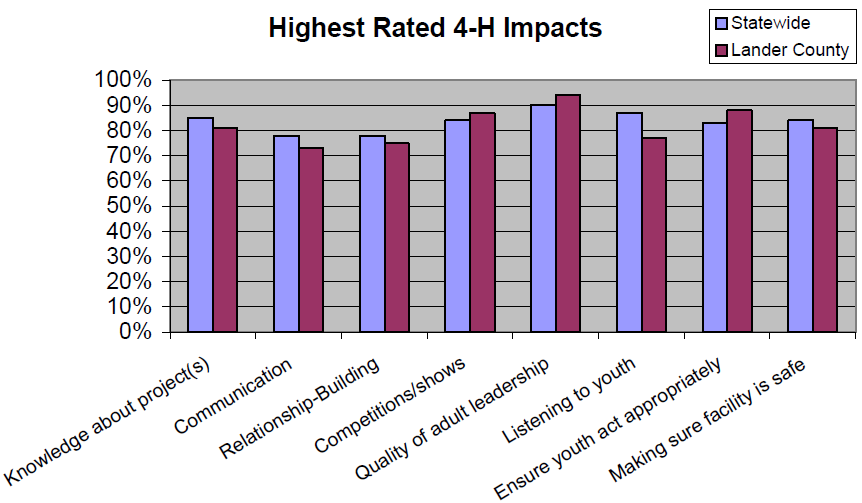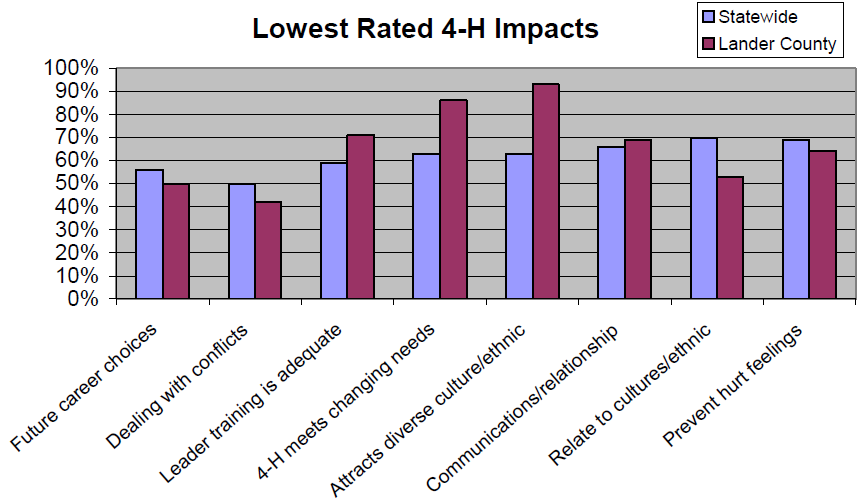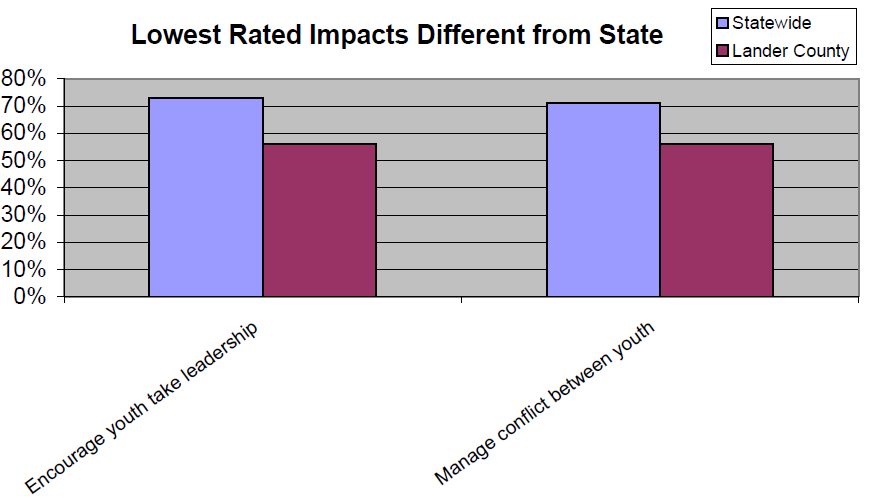Introduction
In continued efforts to assess 4-H program impacts, in 2003, University of Nevada Cooperative Extension surveyed all 4-H parents and leaders statewide. The results were sorted by county. Understanding impacts at the county level is important because 4-H programs in Nevada are managed at the county level. This fact sheet reports the statewide impact assessment results highlighting Lander County. The purpose of this report is to inform 4-H parents, leaders and youth members how 4-H impacts their lives, and also assist 4-H professionals to develop an action plan to further strengthen Lander County 4-H.
Designing and Conducting the Assessment
In designing a tool to assess 4-H program impacts, two models for youth development were used. The first model is based upon six outcomes to expect from successful youth development. These outcomes are confidence, competence, caring, connection, contributing, and character (Blyth, 2000).
Successful youth development helps children become: confident they can make a difference; competent through their ability, skills, and knowledge, and; able to work with people in a way that develops and promotes caring relationships. These youth connect beneficially with people and organizations, contribute their services to make a difference in their personal development as well as in their community, and demonstrate responsible and honest character, or a sense of who they are Another model for youth development used to develop the assessment questions focuses on “core concepts” and provide a basis for successful youth development programs in Nevada (UNCE, 1993). Such programs produce youth who:
- learn and practice self-responsibility and social responsibility to feel accountable and in control of their lives;
- recognize when and how to make informed decisions and implement decisions to solve a problem or achieve goals;
- communicate effectively in both verbal and written form, to share thoughts and feelings which increase social competence, and;
- obtain career and occupational information to help prepare for the world of work.
Questions developed for this assessment were based upon the six desired outcomes of positive youth development and Nevada’s “core concepts” for teaching life skills. Combining models resulted in nine questions to assess the effectiveness of 4-H in teaching youth life skills and six questions to assess social skills youth learn; six questions to measure the effectiveness of traditional 4-H teaching tools and; four questions to assess efficacy of program management goals.
In addition, eighteen questions were developed specifically to assess parent and volunteer leader skills to teach youth, manage 4-H programs and prevent negative and high-risk behavior among 4-H youth. These questions were based on skills established by the National Committee on Community Programs to Promote Youth Development (Eccles and Appleton-Gootman, 2002). These questions were designed to assess the indirect impacts of Nevada 4-H on the parents of 4-H members and volunteer leaders.
Participants in the assessment included all parents and adult volunteer 4-H leaders currently enrolled in Lander County. These participants were selected based on the rationale that 4-H leaders and parents of 4-Hers have the most frequent opportunity to observe any changes that occur among youth participating in 4-H programs.
Each individual was mailed a two-page questionnaire with instructions, and a self-addressed and stamped return envelope. Also included was a cover letter that explained the purpose of the survey, ensured confidentiality to participants, and thanked them for their participation. Of the 34 survey recipients, 17 returned completed questionnaires resulting in a 50 percent response rate.
Statewide and County Impacts
On a scale of 1 to 5 with “1” being “very low” and “5” being “very high,” respondents were asked to circle the number that best indicates how effectively 4-H is developing youth and impacting adults involved. The results are presented by highest and lowest ratings. Results for Lander County are presented alongside statewide impacts for comparison purposes.
The highest rated impacts are illustrated in Figure 1. Individual questions are listed below each bar graph to specify and illustrate the percentage responses for each question.
According to the assessment results the top life skill in Lander County youth learn is: knowledge about the project in which he/she participates. The highest rated social skill youth learn is: to trust others and be trustworthy. In terms of 4-H teaching and program management goals, the highest rated impacts in Lander County are: 4-H projects offered satisfy a variety of subject matter interests and alterative 4-H projects such as snowboarding and/or shooting sports, teach my child valuable skills. For 4-H parents and volunteer leaders, the highest rated parent and leader teaching skill is: letting youth know I have high expectations of them; program management skill is: ensuring that youth act appropriately in the 4-H program; and prevention skill is: making sure that the facility where we have 4-H is safe.
Figure 2 illustrates areas to target for improvement in Lander County 4-H. According to the assessment results, the lowest rated life skill Lander County youth learn is: skills useful in dealing with conflicts. This is also the lowest rated social skill youth learn is the same statewide. In terms of 4-H teaching and program management goals, the lowest rated impacts in Lander County are: leader training is adequate and 4-H meets changing needs of youth. For 4-H parents and volunteer leaders, the lowest rated parent and leader teaching skill is: encouraging youth to take leadership roles; program management skill is attracting diverse culture/ethnic groups; and prevention skill is: making sure the 4-H facility is safe.
Finally, Figure 3 illustrates highest rated impacts for Lander County as compared with state impacts. For example, in contrast with state results, Lander County rated the highest life skill youth learn, trust others and be trustworthy (80%). Also rated differently from state responses is highest teaching tool: alternative projects teach valuable skills (92%). Highest rated parent and leader teaching skill in Lander County is: 4-H satisfies diverse interests (100%); and highest rated parent and leader management skill is: letting youth know I have high expectations of them (88%).
Figure 4 illustrates the lowest rated impacts for Lander County as compared to the state results. Only two differences were found for Lander County. For example, Lander County rated dealing with conflicts (42%) as compared with statewide (50%). Also, Lander County rated the life skill, helping youth manage conflicts between youth lower (56%) compared with statewide (71%). These examples illustrate the need to compare and contrast county results with statewide results.
Figure 1

Data From Figure 1
Figure 2

Data From Figure 2
Figure 3

Data From Figure 3
Figure 4

Data From Figure 4
Developing an Action Plan to Strengthen Lander County 4-H
To develop an action plan, Lander 4-H professionals combined assessment results with available demographic information. Table 1 illustrates these demographics for Lander County.
Table 1. Lander County Demographics
| Category |
Amount |
| Number of school-age children in Lander County |
1,276 |
| Total number of 4-H youth in Lander County |
81 |
Largest ethnic group of public school enrollment in Lander County
(AI/AN) 62 (As) 9 (H) 266 (B) 2 (W) 937 |
White 73.5% |
| Largest ethnic group of 4-H in Lander County |
White 80% |
| Median income of families in Lander County |
54,900 |
| Income distribution of 4-H families in Lander County |
55,000 |
| Percent 4-H families in Lander County earning below $25,000 annually |
11.5% |
| Percent of families in Lander County earning below $25,000 |
25% |
The resulting action plan for Lander County 4-H includes the following three objectives:
- Make leaders aware of the significant impact of using youth leadership in club work and the important impact this makes on both the youth leader and the youth they teach.
- Obtain more training for volunteers to deal better with conflict between youth and groups.
- Obtain professionals to help teach about cultural and diverse lifestyles to members. Find and utilize available curriculum available to use in club settings.
Conclusions
Lander County 4-H will work with volunteers, local professionals, State and Area specialists to try to make youth more comfortable in our programs by addressing and making trainings available to them. We have always made junior and teen leadership available to youth, but apparently our volunteers do not utilize these programs enough to benefit youth. By providing focused training and stressing the importance of these programs and the benefits they offer youth participants, our volunteers may include more youth leadership in program activities.
Lander County 4-H must also offer training focused on dealing better with conflicts between youth. After contacting many of Lander County’s volunteer leaders, we now know most did not realize there was a problem in this area. We will contact UNCE faculty to help with training development and ideas to deal with this area of concern.
The Lander County 4-H Community Based Instructor contacted several people within the county who deal with cultural and diverse background training. Our current plan is to include several speakers to work with our members periodically at club meetings throughout the year.
The Lander County 4-H program is somewhat transient due to the ups and downs of the mining industry which is the mainstay of the county. Implementing this action plan will help make 4-H stronger and Lander County a better place for 4-H youth members and volunteers to live and learn so 4-H can make the best better for all involved.
References
- Blyth, D. 2000. Extension’s Roles in Community Youth Development for the 21rst Century. Communication and Educational Technology Services, University of Minnesota Extension Service.
- Eccles, J., & Appleton-Gootman, J. (2002). Community Programs to Promote Youth Development. Washington, DC: National Academy Press.
- Singletary, L. and M. Smith. 2004. Nevada 4-H Statewide Impact Assessment. Extension Bulletin. EB-04-01. Reno, NV: University of Nevada Cooperative Extension.
- University of Nevada Cooperative Extension. 1993. Youth Development in Nevada, Core Concepts: A Framework for Programming. Tri-fold Brochure.
Figure 1. Highest Rated 4-H Impacts
| Category |
Statewide |
Lander County |
| Knowledge about project(s) |
85% |
82% |
| Communication |
78% |
74% |
| Relationship-Building |
78% |
75% |
| Competitions/shows |
84% |
87% |
| Quality of adult leadership |
90% |
94% |
| Listening to youth |
87% |
77% |
| Ensure youth act appropriately |
84% |
88% |
| Making sure facility is safe |
85% |
82% |
Figure 2. Lowest Rated 4-H Impacts
| Category |
Statewide |
Lander County |
| Future career choices |
57% |
50% |
| Dealing with conflicts |
50% |
42% |
| Leader training is adequate |
59% |
71% |
| 4-H meets changing needs |
64% |
87% |
| Attracts diverse culture/ethnic |
64% |
93% |
| Communications/relationship |
66% |
69% |
| Relate to cultures/ethnic |
70% |
53% |
| Prevent hurt feelings |
69% |
64% |
Figure 3. Highest Rated Impacts Different from State
| Category |
Statewide |
Lander County |
| Trust others to be trustworthy |
73% |
80% |
| Alternative 4-H projects teach valuable skills |
80% |
92% |
| 4-H projects offered satisfy diverse interests |
78% |
100% |
| Let youth know I have high expectation |
81% |
88% |
Figure 4. Lowest Rated Impacts Different from State
| Category |
Statewide |
Lander County |
| Encourage youth take leadership |
74% |
56% |
| Manage conflict between youth |
71% |
56% |


